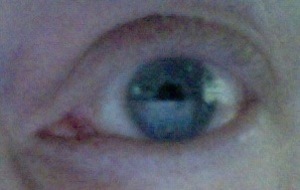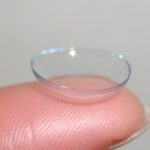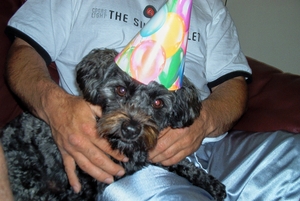I’d been sticking my fingers in my eyes for almost 20 years, putting in and taking out contact lenses, and there were plenty of people around me who asked me not to talk about it or do it in their presence. Learning to get past that eeuw factor, I knew, was entirely worth the difference in functional vision, especially in the periphery, from the thick lenses I’d worn out in front of my eyes for another 30 years before. My eyeballs are way out of shape, and not in the way of my torso. I’m farsighted and astigmatic, which means that even when they were young and flexible, my natural lenses couldn’t bend and stretch far enough to make the focal point of the incoming light rays land where it belonged, on my retina.
Now I was having a fight with my longtime eye doctor about how I was wearing my contacts. He wanted to send me back to glasses, and I was beyond unwilling, no matter what fashion says. Because of my oddballs, he noted the only other treatment option was replacing my internal lenses with corrective implants. He confirmed that my lenses were starting to yellow and cloud, the development associated with aging, diabetes, and other conditions and commonly known as cataracts.
The thing about cataracts is that, once you have them, they can only get worse. And the only treatment is to take the diseased lenses out. In my grandparents’ day, they didn’t do that until vision was almost completely clouded, like the dogs you see with milky-looking pupils. After they took out the cataracted lenses, you had to wear glasses even thicker than mine to be able to see anything.
Intraocular lenses ‘” direct replacements for the cataracted natural lens ‘” were developed in the 1940s,1 but weren’t used routinely until later in the 20th century. Now swapping cloudy lenses for implants is the most common surgical procedure in the U.S.2 (Of course, most of us who have it get it twice.) Because the implants are made to correct things like my farsightedness, they mean freedom from both contacts and glasses.
I had several weeks, after I changed ophthalmologists, to balance my excitement over that freedom against the eeuw. I knew that the procedure was done under minimal anesthesia and I would be awake. I would see what Dr. Sinatra* was doing, more or less. I wondered how much. In my case, I did get a sort of preview, because Dr. Sinatra wanted to burn a little laser hole in each of my irises for another issue. That let me see a piece put in to keep my lids from involuntarily sacrificing themselves. It let me experience a little zap, like I’d touched a live battery, coming at me. I handled that pretty well. The excitement was winning out.
I had to do a week back in glasses before the A-scan appointment, when Dr. Sinatra calculated and we discussed what implants to order for me. It’s even more complicated than glasses or contacts. There are multifocal lenses, and torics to compensate for corneas that are misshapen, the cause of my astigmatism. But insurance companies generally don’t pay for anything but “monofocal” lenses. You can, however, get one eye corrected for best distance vision and the other for best reading. Your brain sorts it out. Really. I’ve had it for years with my contacts.
After the A-scan, I had my last experience with my contacts. The surgeries were scheduled just two weeks apart. There were the usual pre-op tests to arrange. My endocrinologist was delighted I was going ahead, so I wouldn’t have that complication of diabetes to worry about. Three days before the surgery, I had to go back to glasses because I had anti-inflammatory drops to put in that eye, a total of six a day, and my contacts wouldn’t stand up to going in and out that often.
Into the arena
So I arrived at the day-surgery center, got the bracelet with my own personal bar code, got changed into a gown from the waist up, slipper socks, and a shower cap, got my face washed, my vitals taken, and an IV in place. The nurses administered another variety of drops and marked above my brow so nobody would be confused about which eye to work on. I consulted with the anesthesiologist, Dr. Sinatra checked in, and then I walked around the corner to the operating room.
There was a little brick at the top of the table, and they asked me to put my head up against the vertical at the right end. The anesthesiologist, on that side, opened the shoulders of my gown and applied heart-monitor contacts. He settled a nose tube for oxygen on my face and over my ears, but I didn’t catch how he said it might smell. No matter, there’s very little I can smell. Someone drew up my warm blanket around my arms and body into a reassuring swaddle. It wasn’t long before a blue drape was placed over the eye in waiting, and I suppose the sedative must have been administered, because the eeuw was way, way in the background. I was hardly even curious. I experienced just a touch of anxiety when someone asked me to let them know if I needed to cough, but I was too calm to follow through on the implications.
I recognized the feelings of a kind of collar being fitted inside my eyelids, but I merely found it reassuring to know I didn’t have to worry about blinking. I could see vague shadows moving beyond the blue that covered my other eye, and the operative one was pretty much filled with a white light, totally unfocused and unfocusable with the pupil dilated to the extreme.
All I felt was slight pressures on my eyeball as Dr. Sinatra set to work. She asked me to look “a little right” and later “down.” She cut in along the side of the cornea, about where you see the iris begin, and parallel to the outside corner, but it’s only a tiny nick and I hardly knew she was doing it. I did not have to see a scalpel coming at my eye. I was watching where the generalized light had turned to a white blob, fairly well defined, that someone seemed to be pushing around.
Dr. Sinatra detached my lens and removed it. For a moment the defined white blob went generalized halo again. Then, as the pressure from outside my field of vision signaled Dr. S was sliding the folded implant in, came the big surprise: As it unfurled and settled in, I assume with some assistance from the good doctor, the white blob seemed to shift and shake itself into the clearly defined shape of a squared-off, thick letter C. I was just puzzling what this might be when Dr. Sinatra said “all done” and started removing things from me. To my amazement, I realized it must be the filament in the lamp she’d used to do her work, sharp as can be.
The new eye
I got very excited, positively, as they detached me from various systems, took off the blue drape, and wheeled my bed out to Recovery. Immediately I was sat up, relieved of my showercap, and encouraged to try out my eye. Dr. Sinatra sailed by and asked what I thought of the color difference. I hadn’t expected to see a difference, having minimal cataracts, and at that moment still had an afterimage of the lamp filament. Shortly after, though, I was making everyone around me nuts (how many times a week do these nurses get to see someone make these discoveries?) with closing one eye and then the other to compare the colors. Without my noticing it, even my slight cataracts had given my pale skin more color than it deserved, made the hospital walls sort of gray when they were brilliant white, — Well, I could make you nuts too.
Before you knew it, I was enjoying a snack, and my husband was brought in to help me dress and depart. My body knew the rest of the day that it had been insulted, and it took overnight for the dilation to subside entirely. We thought it was a joke when the Recovery nurse told my husband I wasn’t allowed to do housework. But the next morning in Dr. Sinatra’s office I learned ‘” by alarming her staff ‘” that I musn’t bend over for five weeks. The incision isn’t stitched or glued or closed other than by healing, and it could leak under pressure.
There are yet more drops over the five weeks of recovery, and once the second eye was done, my greatest challenge became keeping the dosing schedules straight. But it’s doable. I keep a freshly operated eye covered only at night, to prevent accidental poking or rubbing at it. I wear wraparound sunglasses when I go out, also to prevent stuff getting into my eyes. I’m a little disappointed that, because of my extreme prescription, Dr. S had to get me implants that leave me slightly nearsighted. That takes some getting used to after a farsighted lifetime, and I may need driving glasses, at least when I need to read signs on an unfamiliar highway well in advance. But my readers lie abandoned around my house, and my old bifocals? Where are they, anyway? Who cares? I can see! And I don’t even have to put my fingers in my eyes any more.
* Melanie Sinatra, M.D., F.A.C.S., Wyckoff Ophthalmology, Wyckoff NJ
Sources:
1. Foundation of the American Academy of Ophthalmology, Ophthalmic Heritage and Museum of Vision: Cataract Surgery in the 20th and 21st Century
2. That is, the most common service code recorded for Medicare benefits in 2002. U.S. Department of Health and Human Services, Centers for Medicare and Medicaid Services, cited in American Academy of Ophthalmology Preferred Practice Patterns, “Cataract In the Adult Eye,” September 2006.
More information:
American Academy of Ophthalmology Cataract simulator
“Types of Lens Replacement” eHow Health




